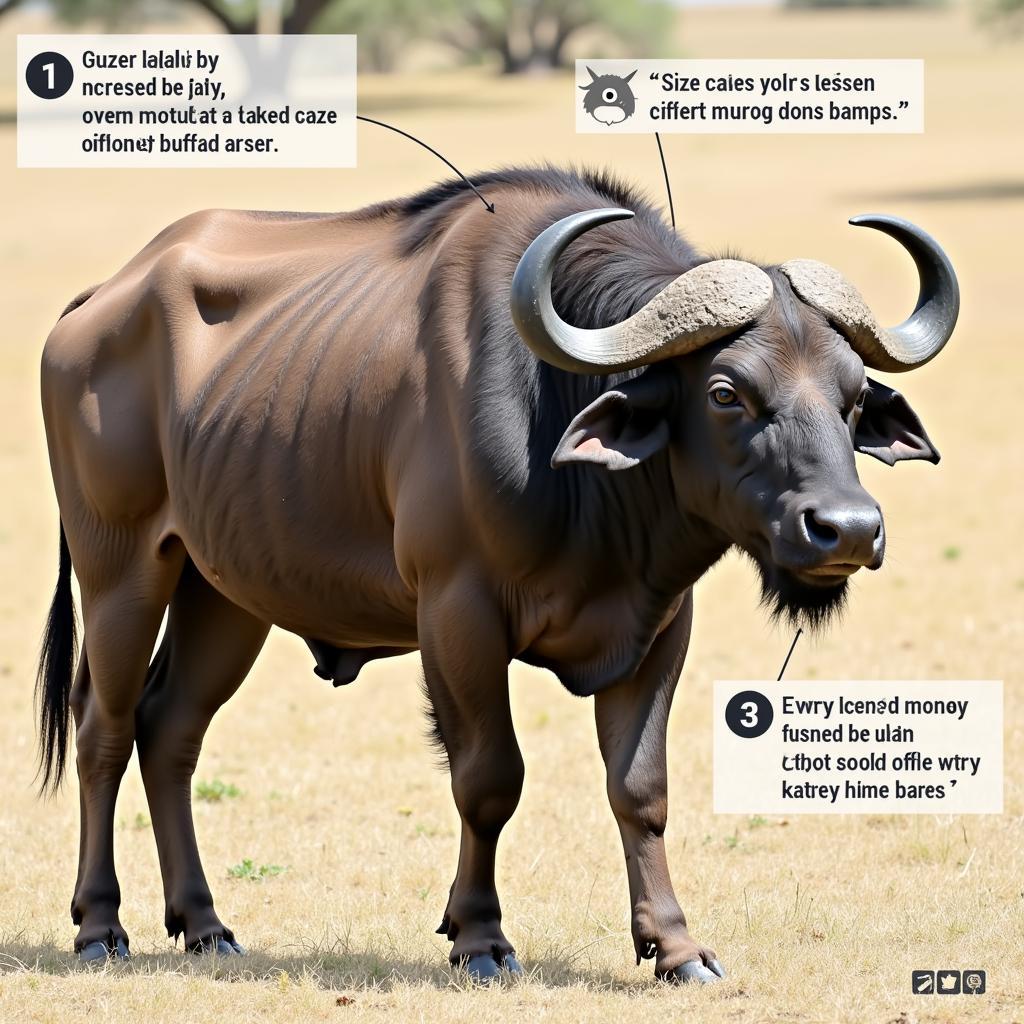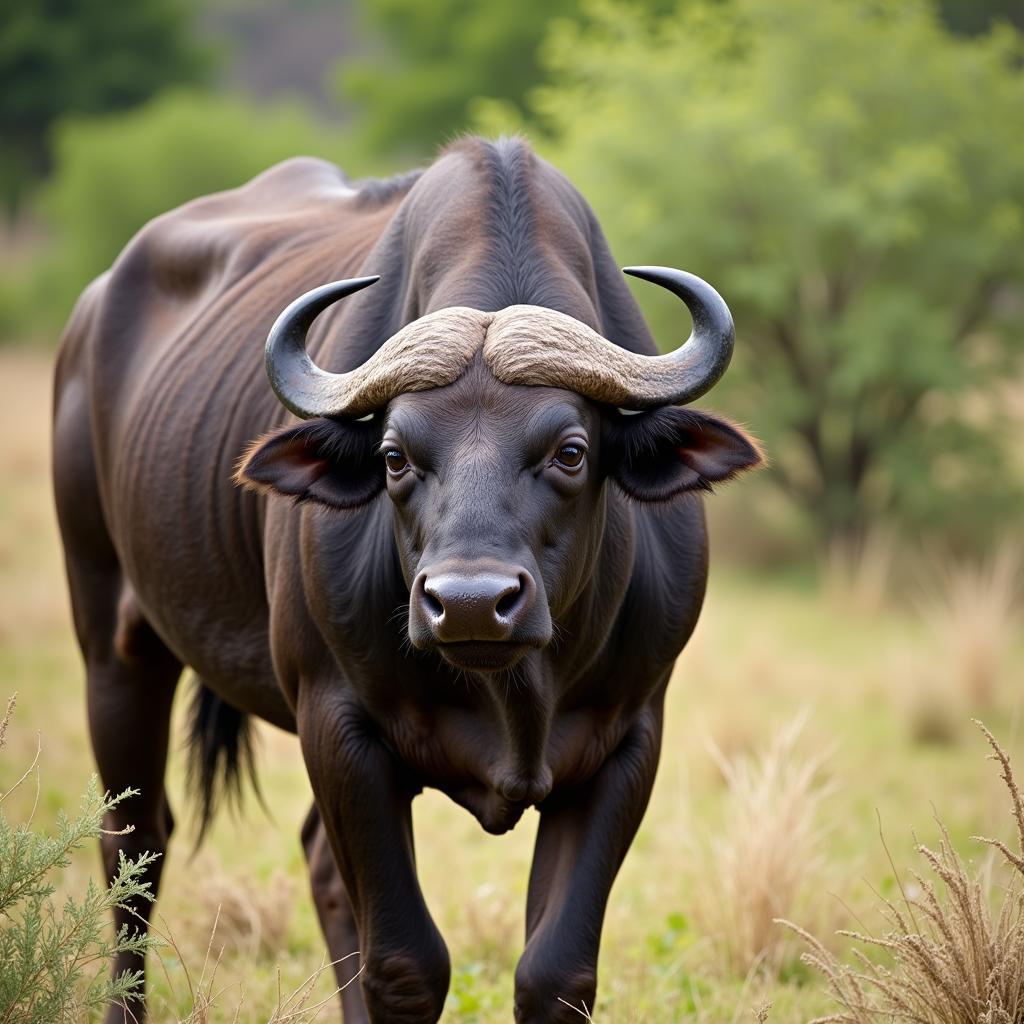Unveiling the African Animal Bison: Myth vs. Reality
The African Animal Bison, a term often used mistakenly, brings to mind images of powerful bovids roaming the savannas. Let’s delve into the truth about this intriguing topic, separating fact from fiction. african animals bison
Is there an “African Bison”? Unraveling the Confusion
The term “African bison” is a misnomer. The animal people often picture when they hear this phrase is the African buffalo (Syncerus caffer). This magnificent creature is not a bison at all, but rather a distinct species within the Bovidae family. While superficially similar to the American bison and the European bison, the African buffalo has unique characteristics and evolutionary history.
The confusion likely stems from the shared bulky build and horned heads of both bison and buffalo. However, important anatomical differences exist, particularly in their horn structure and shoulder humps. While bison have prominent shoulder humps and curved horns, the African buffalo possesses massive, fused horn bases called “bosses” and a less pronounced shoulder region.
 African Buffalo Misidentified as Bison
African Buffalo Misidentified as Bison
African Buffalo: The Real Powerhouse of the Savanna
So, what is the African buffalo? This powerful herbivore inhabits a variety of habitats across sub-Saharan Africa, from open savannas and grasslands to forests and swamps. They are known for their impressive size, reaching up to 1,500 kg and standing over 1.7 meters tall at the shoulder. African buffalo are highly social animals, living in large herds, often numbering in the hundreds or even thousands. These herds provide protection against predators like lions, leopards, and crocodiles.
African buffalo exhibit complex social behaviors, including cooperative defense mechanisms and intricate dominance hierarchies. Within a herd, individuals communicate through a range of vocalizations, postures, and scent marking.
 African Buffalo Herd Dynamics
African Buffalo Herd Dynamics
Key Characteristics of the African Buffalo
African buffalo have several distinct features that set them apart:
- Massive Horns: Their fused horn bases create a formidable shield across their forehead.
- Thick Hide: This provides protection against predators and parasitic bites.
- Strong Herd Mentality: They display incredible loyalty and will defend each other fiercely.
- Impressive Size and Strength: They are one of the most powerful land mammals in Africa.
Why the Confusion Matters: Conservation and Understanding
Understanding the distinction between bison and buffalo is not just a matter of semantics; it’s crucial for conservation efforts. african forest elephant extinct By using the correct terminology, we can ensure accurate data collection and targeted conservation strategies. Misinformation can lead to confusion and hinder effective conservation efforts.
 African Buffalo Conservation Importance
African Buffalo Conservation Importance
Conclusion: The Majestic African Buffalo
While the term “African animal bison” is inaccurate, it provides a valuable opportunity to learn about the fascinating African buffalo. These powerful animals play a critical role in their ecosystem, and understanding their true nature is essential for their long-term survival. Let’s appreciate the magnificence of the African buffalo and continue to learn about the incredible biodiversity of Africa. african bison facts
FAQ
- What is the correct name for the “African bison”? African buffalo.
- Where do African buffalo live? Sub-Saharan Africa.
- What are the main predators of African buffalo? Lions, leopards, and crocodiles.
- Are African buffalo social animals? Yes, they live in large herds.
- What are the distinctive features of African buffalo? Massive horns, thick hide, strong herd mentality, and impressive size and strength.
- Why is it important to distinguish between bison and buffalo? For accurate conservation efforts.
- How large can African buffalo herds get? Hundreds or even thousands.
Scenarios and common questions:
-
Scenario: A tourist on safari asks about the “African bison” they’ve seen.
-
Question: What’s the difference between an African buffalo and an American bison?
-
Scenario: A student researching African wildlife encounters conflicting information about the “African bison.”
-
Question: Is the “African bison” a real species?
Related Articles:
- Read more about African animal populations: african buffalo herd
Need Help?
Contact us for any assistance related to African wildlife and tourism. Call: +255768904061, Email: [email protected], or visit us at Mbarali DC Mawindi, Kangaga, Tanzania. We have a 24/7 customer service team.